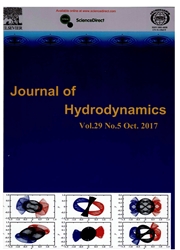

 中文摘要:
中文摘要:
地震主震发生之后通常伴随余震.多次地震下结构的损伤破坏累积效应明显,只考虑主震的重力坝抗震设计是不完善的,应考虑整个地震序列的影响.采用塑性损伤力学对重力坝进行非线性动力分析,揭示了主余震型地震序列下的重力坝损伤演化特征和结构能量耗散机理,通过包含能量特性的大坝定量损伤指标评价了余震作用对结构安全性的影响.实例分析结果表明:主震和余震阶段,重力坝动力耗散能均以阻尼耗散能量为主,混凝土塑性耗散能次之,损伤耗散能所占比例最小;从损伤评价指标看,余震阶段重力坝的损伤主要体现在坝体中上部损伤区域的进一步扩展演化;余震作用使坝体塑性变形较单一主震作用下显著增大,从变形控制的角度,设计中需考虑包含余震波的地震序列对结构抗震安全的影响.
 英文摘要:
英文摘要:
Earthquake has the character of cluster with many aftershocks after the main shock. The effect of the whole seismic sequence on the dynamic characteristic of gravity dam should be considered. Damage evolution effect of the dam is analyzed under the experience of different mainshock-aftershock seismic sequences by plastic damage mechanics method based on the energy equivalent principle, the damage evolution role and energy dissipation mechanism of the dam are revealed, and also the damage level of the dam is described by seismic damage assess- ment model considering damage energy dissipation. The example shows that, the vibration energy and the earth- quake responses of the structure are reduced effectively by the structural damping; little amount of the seismic ener- gy is dissipated by concrete damage and plastic dissipation ; the damage of the middle and upper part of the dam is the main damage of the structure under aftershocks. It is the aftershocks which make plastic deformation of the dam increase significantly, so that the influence of the whole seismic sequence which contains the aftershocks should be considered.
 同期刊论文项目
同期刊论文项目
 同项目期刊论文
同项目期刊论文
 Two-phase flow numerical simulation of a bend-type ice sluice in the diversion water channel of powe
Two-phase flow numerical simulation of a bend-type ice sluice in the diversion water channel of powe Experimental study on the bed topography evolution in alluvial meandering rivers with various sinuou
Experimental study on the bed topography evolution in alluvial meandering rivers with various sinuou Analysis of agricultural pollution by flood flow impact on water quality in a reservoir using a thre
Analysis of agricultural pollution by flood flow impact on water quality in a reservoir using a thre Three-dimensional simulation of the water flow field and the suspended-solids concentration in a cir
Three-dimensional simulation of the water flow field and the suspended-solids concentration in a cir Numerical investigation on vortex-induced vibration of an elastically mounted circular cylinder at l
Numerical investigation on vortex-induced vibration of an elastically mounted circular cylinder at l An Integrated Groundwater Management Mode Based on Control Indexes of Groundwater Quantity and Level
An Integrated Groundwater Management Mode Based on Control Indexes of Groundwater Quantity and Level Short-term optimal operation of Three-gorge and Gezhouba cascade hydropower stations in non-flood se
Short-term optimal operation of Three-gorge and Gezhouba cascade hydropower stations in non-flood se Risk identification on hydropower project using the IAHP and extension of TOPSIS methods under inter
Risk identification on hydropower project using the IAHP and extension of TOPSIS methods under inter The effects of strong motion duration on the dynamic response and accumulated damage of concrete gra
The effects of strong motion duration on the dynamic response and accumulated damage of concrete gra Observation of microscopic damage accumulation in brittle solids subjected to dynamic compressive lo
Observation of microscopic damage accumulation in brittle solids subjected to dynamic compressive lo Laboratory observation of acoustic fluidization in granular fault gouge and implications for dynamic
Laboratory observation of acoustic fluidization in granular fault gouge and implications for dynamic Laboratory measurements of the rate dependence of the fracture toughness anisotropy of Barre granite
Laboratory measurements of the rate dependence of the fracture toughness anisotropy of Barre granite Optimal sensor placement for large structures using the nearest neighbour index and a hybrid swarm i
Optimal sensor placement for large structures using the nearest neighbour index and a hybrid swarm i Joint impact of rainfall and tidal level on flood risk in a coastal city with a complex river networ
Joint impact of rainfall and tidal level on flood risk in a coastal city with a complex river networ Eulerian-Eulerian solid-liquid two-phase flow of sandstone wastewater in a hydropower station rectan
Eulerian-Eulerian solid-liquid two-phase flow of sandstone wastewater in a hydropower station rectan Research on virtual-reality interactive simulation for concrete dam construction process based on ve
Research on virtual-reality interactive simulation for concrete dam construction process based on ve Seismic cracking analysis of concrete gravity dams with initial cracks using the extended finite ele
Seismic cracking analysis of concrete gravity dams with initial cracks using the extended finite ele Constructioin Schedule Real-time Control Coupling Consruction Quality in Large Scale Underground Pow
Constructioin Schedule Real-time Control Coupling Consruction Quality in Large Scale Underground Pow Comprehensive Evaluation of the Coupling Construction Progress and Quality of High Core Rockfill Dam
Comprehensive Evaluation of the Coupling Construction Progress and Quality of High Core Rockfill Dam Joint probability distribution of winds and waves from wave simulation of 20 years (1989-2008) in Bo
Joint probability distribution of winds and waves from wave simulation of 20 years (1989-2008) in Bo Construction Schedules Simulation and Prediction of Water Conveyance Tunnel Based on Karst Geologica
Construction Schedules Simulation and Prediction of Water Conveyance Tunnel Based on Karst Geologica Research on Management Information System for Construction Consultant in Hydropower Project Based on
Research on Management Information System for Construction Consultant in Hydropower Project Based on A Study on the Controllability of Deepwater Manifold during Launch through Pendulous Installation Me
A Study on the Controllability of Deepwater Manifold during Launch through Pendulous Installation Me Research on Construction Schedule Real-Time Control of High Core Rock-Fill Dam Based on Digital Moni
Research on Construction Schedule Real-Time Control of High Core Rock-Fill Dam Based on Digital Moni Tracking methods for free surface and simulation of a liquid droplet impacting on a solid surface ba
Tracking methods for free surface and simulation of a liquid droplet impacting on a solid surface ba Finite element analysis on thermal upheaval buckling of submarine burial pipelines with initial impe
Finite element analysis on thermal upheaval buckling of submarine burial pipelines with initial impe 期刊信息
期刊信息
